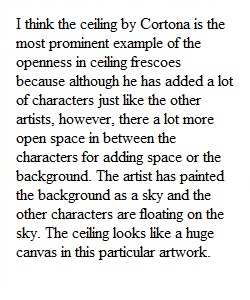


Q In this lesson, we see a theme similar to painting that uses architectural space as its organizing framework, but in these new examples we've seen, this happens in a very different way. In the example of Michelangelo's Sistine ceiling we have the effect of separate panels, and in Pozzo's Glorification of Saint Ignatius, the final images are more unified. Given all that you have learned, where would you place these additional ceiling frescoes in terms of their degree of relative openness vs. closure? Provide an order and state why you decided on that order. The "why" here involves using concrete language to describe the formal/visual properties of each example in order to clarify why you choose that order. As we have been doing in previous lessons, draw parallels to examples we have discussed previously. The best starting place would be to start by considering the frescoes Anthony discusses in the video on the previous page. You will find that, by making reference to these examples, you will also start to employ formal/descriptive terminology that will make your discussion more specific.
View Related Questions